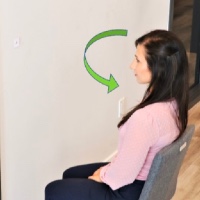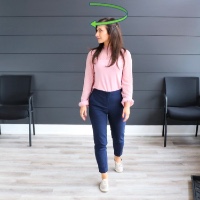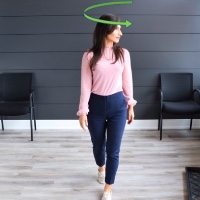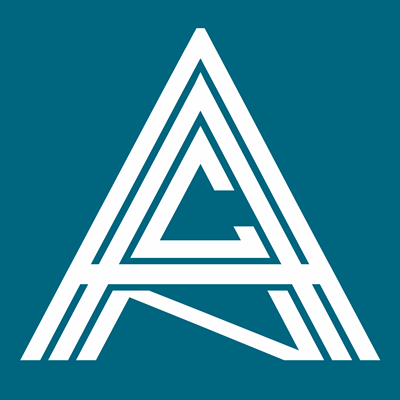These are challenging times for most of us. Covid-19 results in altered routines, social isolation, changes to anxiety and depression, and fewer opportunities to meet with the health care providers that we rely on. These factors are especially magnified when you suffer from vestibular impairment. As a certified vestibular physiotherapist in Toronto, I am keenly aware of the struggles that patients have been grappling with these past few months. I’ve provided some tips to help you manage your dizziness and even reduce your dysfunction while you isolate at home.
If you’re reading this, you’re likely already aware of the effects that an acoustic neuroma has on your vestibular system. The pressure that this benign growth can assert on your vestibular nerve (part of your 8th cranial nerve) can produce a wide range of symptoms, and potentially leave you with a mild to severe disability.
These vestibular symptoms can include: dizziness, poor balance, motion sensitivity, difficulty focusing while your head is moving. Patients are often unable to live their lives as they’ve done before, affecting their ability to participate in physical activities, work at their jobs, and interact with their family and friends.
VESTIBULAR EXERCISES at HOME
Many patients with vestibular symptoms related to a schwannoma have already been assessed and received treatment from a vestibular physiotherapist. This means you’ll have a home exercise prescription that is specifically created for your unique presentation and modified to fit your recovery pattern.
However, many of you haven’t seen a professional or perhaps the coronavirus has made your rehabilitation appointments difficult to keep. To help you manage, I’ve provided some exercises you can try at home that may help. These don’t require fancy equipment and are generally safe for most vestibular conditions. Please note that vestibular rehabilitation is not a one size fits all solution, and best outcomes require a detailed assessment and skilled follow up visits with an experienced health professional.
1. Gaze Stabilization (Vestibular-Ocular Reflex)

This exercise addresses a core and basic vestibular function. Ensuring your eyes stay focused where you want them when your head moves or is repositioned.
-
Print or cut out a letter A (about 1cm in height) and tape it to the wall so it is at head level when you are seated.
-
Sit in a chair about arm’s length away from the letter A.
-
Keep your eyes glued to the letter A, while turning your head left and right. About 1⁄2 turn in both directions.
-
Repeat for 2 minutes
2. Standing Balance

Balance, and our sense of where our head and body is in space, is another core vestibular function. This exercise acts as a foundation for our vestibular system, allowing us to feel grounded when performing most other motions and activities.
-
Stand with feet together in front of a picture on your wall, with a chair behind you (for safety)
-
Focus on something specific in the picture for 10 seconds
-
Close your eyes for 10 seconds while maintaining your balance
-
Repeat for 2 minutes
3. Ball Throwing and Tracking


Our vestibular system allows us to track moving objects even while our head is in motion. When this function is impaired, you may experience difficulty with activities such as shopping or watching traffic as you’re trying to cross the street.
-
You’ll need a tennis ball or something similar
-
Stand up straight and throw the ball from one hand to the other.
-
Keep your eyes on the ball at ALL TIMES and let your head move with the ball, as well
-
As you get more comfortable, try to throw the ball higher
-
Repeat for 2 minutes
4. Walking with Head Turns


Your gait (walking pattern) is often affected by vestibular impairments, particularly in busy places such as in crowds or at the supermarket. Your vestibular system is responsible for much of the head, eye, trunk and limb coordination that is involved with the simple task of walking.
-
Start at the end of a long hallway or a part of your house where you can safely walk back and forth
-
With your head turned to the left, walk a few lengths of your hallway
-
Repeat with your head to the right
-
Finally try it with your head rotating right and left
-
Repeat for 2 minutes
GENERAL ADVICE
Exercises and Activities
Dizziness is produced when your vestibular system experiences an error in the perception of movement. Generally speaking, the more “errors” you experience, the faster your recovery. This means that you must experience controlled instances of dizziness to get better, faster. The vestibular home exercises I’ve outlined above should produce some mild dizziness (errors) which your brain will correct through compensation. This also means that trying to keep moving and participating in activities that make you a “little” dizzy will help! The worst thing you could do is avoid any motion that makes you dizzy or imbalanced.
Anxiety and Depression
The vestibular system and depression and anxiety have neurological links within our central nervous system. This means that symptoms related to these areas often appear together. This also means that the recovery of one of these systems depends on the positive functioning of the other system. Ensure that you are doing all you can to manage anxiety and depression, or better yet, ask your doctor for more resources to assist you.
Click for article on managing stress, anxiety and a chronic impairment.
https://cornerstonephysio.com/resources/chronic-pain-stress-anxiety-covid-19/
Healthy Eating and Drinking
It’s no secret that what we put into our bodies has an effect on how we heal. The pandemic has made healthy eating and drinking habits particularly difficult to sustain and can directly result in an exacerbation of symptoms. My top tips include:
-
Staying hydrated. Drink more water, less caffeine and alcohol.
-
Decrease dietary salt. Read nutritional labels and fewer shakes with that shaker.
-
Don’t let your blood sugar levels spike. Avoid have a high sugar food after a long fast (e.g. breakfast time!)
Virtual Vestibular Rehabilitation
Battling dizziness and imbalance on your own can be confusing, uncertain, and stressful. And getting help can be difficult when travelling to a clinic, or if leaving the safety of your home is questionable. At my Cornerstone Dizziness Clinic, many vestibular patients have benefitted from virtual or telehealth rehabilitation to connect with a physiotherapist from the comfort of their homes. Learn more about whether this option may be right for you: https://cornerstonephysio.com/resources/can-virtual-physiotherapy-work-for-me

Joon Nah is a certified vestibular physiotherapist with credentials from the Emory School of Medicine and the University of Pittsburgh’s Dept. of Physical Therapy. As someone who has suffered from a chronic vestibular dysfunction himself, he founded the Cornerstone Dizziness Clinic in 2008.
